| Columns Retired Columns & Blogs |
Your review was an absolute pleasure to read - a lot of interesting details and insight into what has made this speaker so special for so many years. Thanks!
I used DRA Labs' MLSSA system and a calibrated DPA 4006 microphone to measure the Quad Reference ESL-2805's frequency response in the farfield, and an Earthworks QTC-40 for the nearfield and spatially averaged room responses. The measuring microphone was placed pointing toward the center of the diaphragm, which, with the 3° tiltback, was on the listening axis in my room. Although I raised the speaker off the ground for the acoustic measurements, I couldn't get it high enough to avoid the early reflection from the floor. This limited the resolution of the measurements in the midrange.
The Quad has a lower voltage sensitivity than specified, my estimate coming in at 82dB(B)/2.83V/m. This will be offset in-room to some extent by the fact that as much sound is being emitted from the speaker's rear as from its front. The ESL-2805 is specified as an 8 ohm design; its impedance dropped to 4 ohms in the high treble (fig.1, solid trace), but otherwise remained relatively high, with a moderately low phase angle. There is a sharply defined impedance peak at 20kHz, below which is a combination of 5.2 ohms and –45° electrical phase angle, which might upset amplifiers not comfortable driving less than 8 ohms. The peak in the bass is related to the diaphragm's fundamental "drumskin" resonance; unusually, the height of this peak will depend on the drive level; the impedance in this region increases with increasing level.
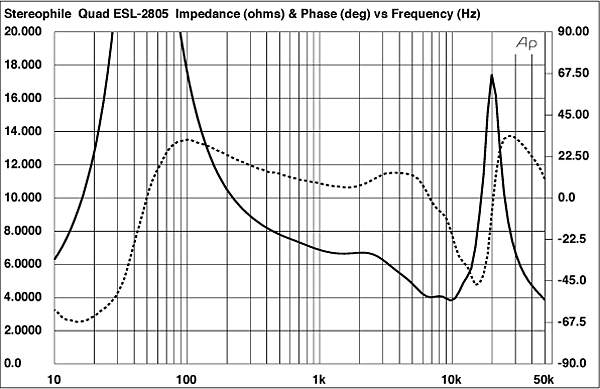
To the right of fig.2 is shown the ESL-2805's farfield response, averaged across a horizontal window of 30° centered on the listening axis. The Quad is remarkably flat from 300Hz to 10kHz, though there are some small, narrow peaks and dips between 4 and 10kHz. The output drops a little above 10kHz, and finally plummets precipitously above 16kHz, which will not be a problem for anyone over the age of 40. Below 300Hz, the trace in fig.3 shows the nearfield response. Though this appears to peak by 10dB between 40 and 90Hz, this is misleading, as this measurement does not show the effect of the cancellation between the front and back waves, which are in opposite polarities. The speaker's low-frequency output is best judged in-room (see later).
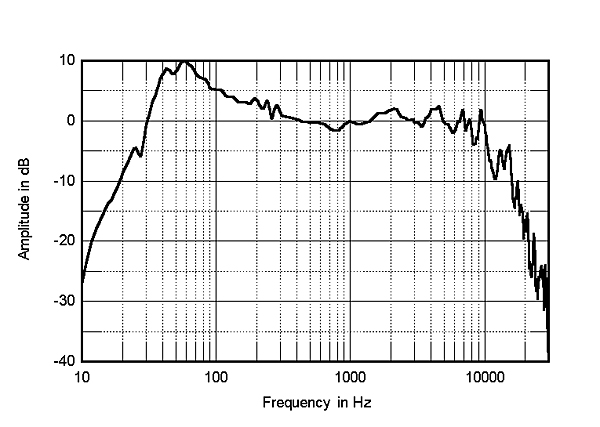
Figs. 3 and 4 show the ESL-2805's lateral dispersion, the former the actual responses off axis, the latter between those responses and the on-axis response. The behavior above 15kHz is difficult to interpret in fig.4 because the on-axis dips tend to fill in to the speaker's sides, resulting in peaks. But looking at both of these graphs, it can be seen that the Quad behaves in classic dipole fashion below 5kHz, with a well-defined null 90° to the side. The dispersion narrows above 5kHz, which might make the speaker sound a little lacking in top-octave air in large rooms. Those sitting more than a little off axis will hear a sound that is significantly depressed in the top two audio octaves. Vertically (fig.5), the ESL-2805 maintains its balance over quite a large (±10°) window, indicating that sitting on the exact listening axis is not too critical.
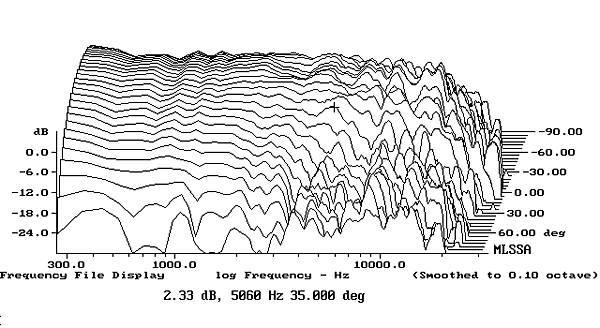


The red trace in fig.6 shows the Quad's spatially averaged 1/6-octave response in my listening room, taken across a 36" by 18" vertical rectangular grid centered on the position of my ears. For reference, the blue trace in fig.6 shows the spatially averaged response of the Sonus Faber Amati Futura, which I reviewed in the March issue. The two speakers have a very similar balance above 1kHz, though the Italian speaker, which I thought somewhat mellow, has a little more energy in the top two octaves. The British speaker has slightly more low-treble output, however. Though both speakers lack a little midrange energy, the Sonus Faber is higher in level in this region and has considerably better low-frequency extension, not rolling off until below 25Hz. By contrast, the ESL-2805 starts to roll off below 100Hz, and though that rolloff is interrupted both by the diaphragm's fundamental resonance and the lowest-frequency mode in my room, the speaker measured (and sounded) lighter in weight than the Amati Futura.
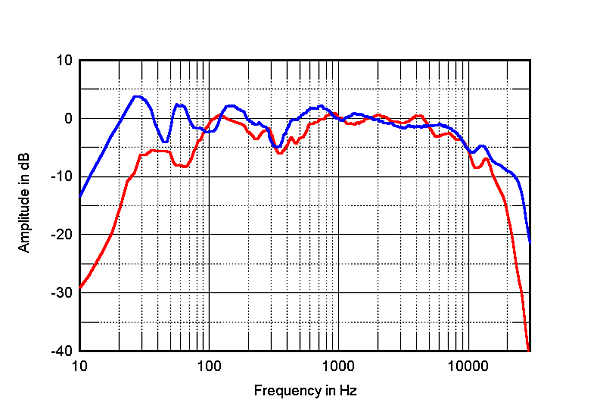
Turning to the time domain, the glory of Peter Walker's splitting of the diaphragm drive into time-delayed concentric rings can be seen in the ESL-2805's step response (fig.7). This has an almost perfect right-triangle shape, broken only by a small dip 300µs after the initial transient and the first reflection of the speaker's sound, from the floor, about 3ms later. As I write in the introduction to this review, this superbly time-coherent behavior allows the Quad to be one of the very few loudspeakers to correctly reproduce a squarewave. Fig.8 shows the waveform of a 500Hz squarewave as produced by the ESL-2805. While the flat tops and bottoms of the wave are disturbed both by that dip seen in the step response and by some high-frequency ringing associated with the top-octave peakiness in the frequency response, this is otherwise an excellent squarewave.
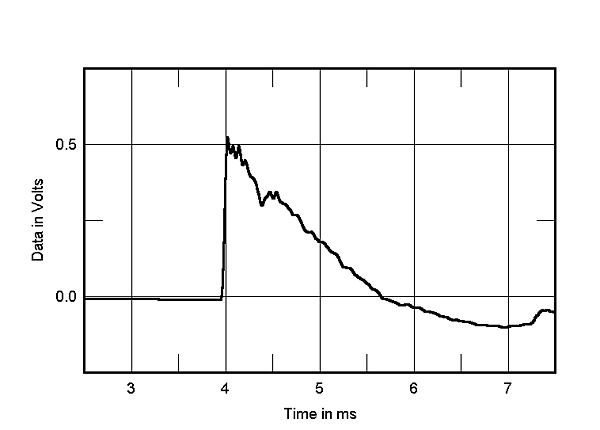

The Quad ESL-2805's cumulative spectral-decay plot taken on the listening axis (fig.9) features a clean initial decay in the midrange and low treble, but those peaks above 5kHz are associated with some ridges of delayed energy.
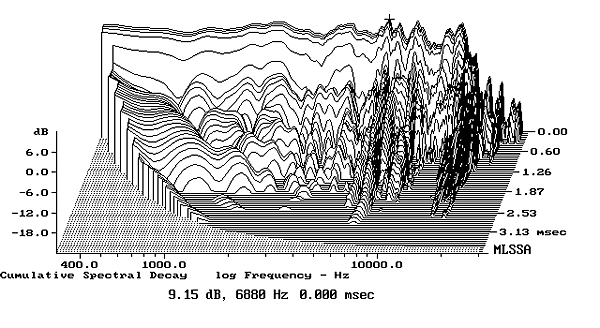
The Quad was always a low-distortion speaker—I remember being with Martin Colloms when he measured an ESL-63 and found that it produced 0.1% THD or less over most of the audioband! Fig.10 shows the spectrum of the ESL-2805's output while it reproduced a 1kHz sinewave at 86dB SPL at 1m. The only harmonics that can be seen are the second, at –72dB (0.025%); the third, at –76dB (0.015%); and the eighth, at –78dB. And while a subharmonic can be seen at 500Hz—as I said in my Richard C. Heyser Memorial Lecture to the Audio Engineering Society in October 2011 (footnote 1), panel speakers behave in a mathematically chaotic manner, which leads to the production of subharmonics—this lies at –70dB (0.03%). The Quad ESL-2805 is considerably more linear than many tube amplifiers!
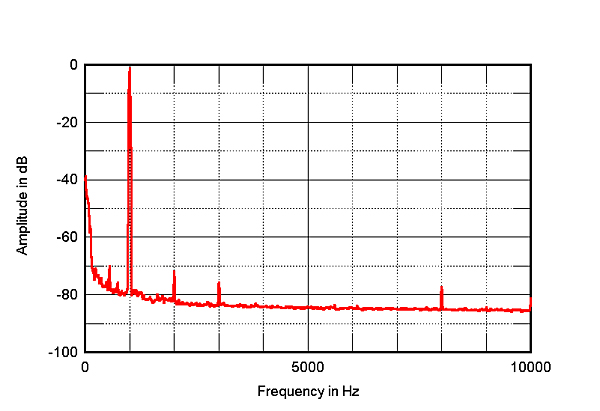
In almost every way, the Quad Reference ESL-2805's measured performance doesn't differ significantly from that of the ESL-63 of 30 years ago. But what was outstanding back then is still superb now.—John Atkinson

Your review was an absolute pleasure to read - a lot of interesting details and insight into what has made this speaker so special for so many years. Thanks!


The US importer, Taiga LLC has closed shop. At this time, Liberty Trading, run by May Audios' Canadian counter-part is the sole NA importer. Also, prices have increased.

This may be a moot point since no one seems to be paying attention to these speakers these days. I have had quality problems with the Quad 2805 speakers made in China. I had to return the speakers to the manufacturer three times and the problem is still not resolved, and they want to charge me for repair. I find it incredible that the manufacturer would not take back a clearly defective product.